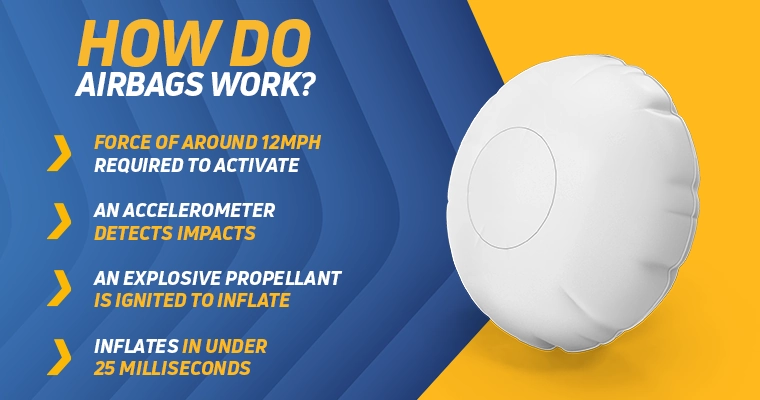How Do Airbags Work?
Jack Dreyer | Thursday 1st September 2022 8:00am


Airbags are a fundamental part of car safety today and are responsible for keeping the occupants of a vehicle safe in the event of a collision. Airbags are so crucial, in fact, that they are checked in MOTs and can be reason enough for failure.
From the early models in the 1950s, to todayís advanced seatbelt prototypes, these inflatable bags, in conjunction with other in-car safety devices, have saved the lives of thousands of road users. Despite this, very few people know how they actually work. If youíre after an explanation for the inner workings of this vehicle safety device, read on.
What are airbags?
In simple terms, an airbag is an inflatable nylon bag that acts like a cushion and is designed to protect the occupants of a vehicle from harm in the event of a collision. These bags full of air (hence the name) have been specifically designed to inflate immediately upon impact and act as a protective cushion to keep the driver and their passengers from harm.
Without them, the people inside a vehicle are far more likely to seriously injure themselves in car accidents by colliding with equipment in the car ó banging their heads or limbs on the dashboard or steering wheel, for example. They are intended to be used in conjunction with the other safety features in a car (this refers to seatbelts and crumple zones) for the most effective protection against the impact of a collision.
When were airbags invented?
Airbags were officially invented in 1951. Before this, car accidents were much more injurious and far more threatening to human life. Amazingly, though, the first car in Europe to be sold with an airbag as an option was in 1980 with the Mercedes Benz S-Class (W126).
That being said, it was only in 1990 when all cars started being fitted with an airbag (at least as an optional extra). Since 2003, when airbags were widely accepted as the norm, the fatality rate of car accidents has fallen by more than half.
You can find out more about the history of car safety features like the airbag in another of our blogs here.

Where are airbags located?
In order to guarantee the maximum impact on the safety of the passengers and drivers, airbags are located all over a vehicle. However, most of them are hidden away in the front of the car as this is the most high-risk area, especially when it comes to head-on collisions.
This is due to the glass in the windshield and the prioritisation of the driverís safety. If the driver bangs their head and loses consciousness, then the vehicle is no longer in control and may cause even more harm to passengers and other road users.
The following areas are common locations for airbags:
- Frontal airbags in the steering wheel in front of the driverís seat and In the dashboard in front of the passengerís seats.
- Knee airbags by the driverís and passengerís feet. These are intended to distribute the force on impact to reduce leg injuries.
- Curtain airbags in the roof rail.
- Centre airbags between the passenger and driver to avoid head collisions.
- Front-row side impact airbags & second-row side airbags. These airbags are intended to protect the head and chest from the side windows, reducing the injuries associated with shattered glass. Due to the small space between the occupant and the window, these airbags must deploy extremely quickly ó within 10-20 milliseconds, in fact!
- Seatbelt airbags. These may not be as common as the rest of the airbags but are useful for protecting peopleís torsos on impact.
When buying a used car, it is important to check whether there are airbags in these areas, and if they are in good working order.
How do airbags work?
When broken down to their core components, airbags are quite simple really. A modern airbag has three key elements:
- The bag
- An inflation module
- A series of impact sensors
From start to finish (or impact to deployment), the procedure is extremely quick. First of all, the car is hit. Depending on the severity of the collision, the airbags may or may not go off. Whether it does or not is determined by the sensors and the amount of force and speed they detect.
These sensors take the form of gyroscopes and accelerometers placed around the outside of the vehicle and are responsible for detecting the magnitude and direction of the forces the car is suddenly subjected to.

Deep inside the vehicle is an Airbag Control Module (or ACM) which constantly monitors the data sent from these sensors like a computer. When a car is hit, it is this piece of equipment that makes the decision as to whether or not to deploy the airbag ó as well as which ones to deploy.
If the ACM gives the all-clear, the inflator immediately blows the airbags up. This is, in itself, a very complex process starting with an electrical charge being sent to the ignitor (a form of heating element). From here, a substance known as a solid propellant is suddenly burnt; this material is most likely to be sodium azide or nitroguanidine ó rapidly acting, odourless chemicals.
This causes a small explosion when exposed to ammonium nitrate which produces enough nitrogen gas to fill the airbag, inflating it. Although this process seems long-winded to describe, it actually only takes 50 milliseconds ó thatís less time that it takes to blink an eye.
Stay safe with Kwik Fit
Air bags are fundamentally there to keep you and your passengers safe, but so are other components of your car. If you experience any issues with your brakes, tyres or any other part of your car, get in touch with the experts at your local Kwik Fit today. Or, for added peace of mind, book in for a vehicle safety check.
Any facts, figures and prices shown in our blog articles are correct at time of publication.
Featured Articles
Is it Illegal to Drive With One Headlight?
Saturday 19th July 2025
Wondering if itís illegal to drive with one headlight? Learn about the safety risks and penalties of illegal blown bulbs and why you should fix them promptly.
Air Con in EVs & Hybrids: Experts Answer Your Questions
Monday 30th June 2025
Does air con drain EV batteries? Can you use the air con while charging an electric car? Find out the answers to these questions & more from Kwik Fitís experts.
Why Is Your Car Making a Noise? Fixes & Tips
Friday 13th June 2025
When your car starts making unexpected noises, it can certainly be quite disconcerting; it may be nothing to worry about, but hereís what you need to know.









